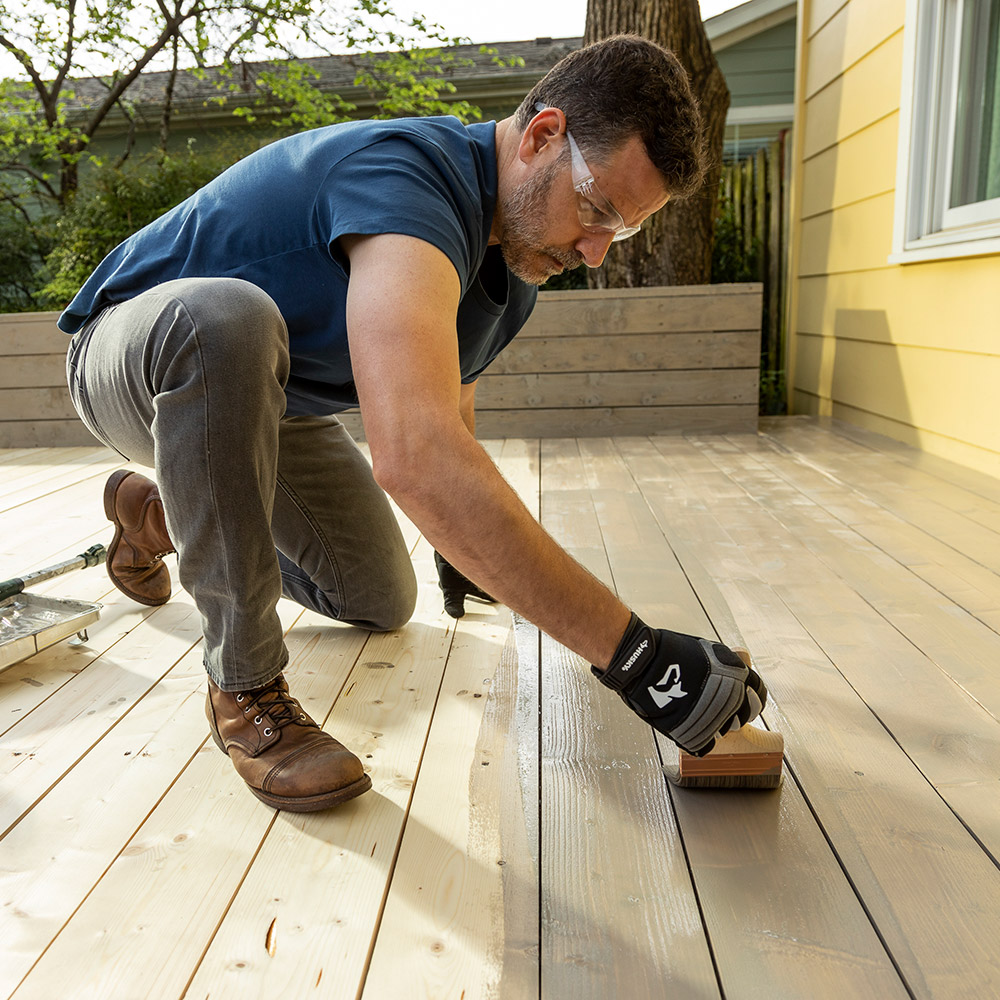Water-Based Stains for a Beautiful Deck: Eco-Friendly and Effective
Water-Based Stains for a Beautiful Deck: Eco-Friendly and Effective
Blog Article
A Comprehensive Overview to Different Kinds Of Deck Discoloration Techniques for Ultimate Security and Aesthetics
In the world of deck maintenance, the art of discoloring stands as a crucial action in the direction of both maintaining the honesty of your exterior room and improving its visual charm. As we browse with the intricate globe of deck discoloration techniques, one starts to value the nuanced strategies that can make all the distinction in between a mediocre coating and a flawless one.
Comprehending Different Kinds Of Discolorations
Different kinds of spots are generally used in the procedure of deck discoloration to achieve various aesthetic and protective effects. On the other hand, semi-transparent discolorations supply a balance in between color improvement and security, allowing some timber grain to reveal with.
Toners add a hint of color to the timber while offering minimal defense, making them appropriate for newer decks with less wear. Recognizing the attributes and advantages of each type of stain is critical for attaining the preferred look and longevity for your deck.
Choosing the Right Discoloration Shade
When taking into consideration the aesthetic appeals of your deck staining task, the choice of stain color plays an essential role in improving the protective top qualities of the chosen discolor type (Right Deck Stain). The color you pick can considerably influence the overall appearance of your deck, as well as its capability to withstand the components with time
When selecting a stain shade, it's necessary to take into consideration the existing color pattern of your home's exterior. Harmonizing the deck stain with the overall aesthetic of your property can develop a visually appealing and natural exterior room. Additionally, the shade of your deck discolor can affect the temperature level of the deck surface area; darker shades tend to soak up even more heat, while lighter shades show sunshine and remain cooler.
In addition, the type of timber you are discoloring will certainly also impact just how the discolor color appears. Different timber varieties can connect with the tarnish in numerous ways, possibly changing the final color. It's suggested to test the tarnish on a tiny, unnoticeable location of the deck to make sure the shade ends up as wanted prior to waging the whole job.
Preparing Your Deck for Discoloration
To ensure a successful and durable deck staining job, comprehensive prep work of the deck surface area is vital. Begin by cleaning the deck thoroughly to eliminate dust, crud, mildew, and any kind of old complete or tarnish.
Evaluate the deck for any damaged or rotten boards that need to be changed. Hammer down any sticking out nails and sand any type of rough locations to make certain a smooth surface for discoloration. Check for any loose railings or actions that might require tightening or repair.
As soon as the deck is tidy, dry, and in excellent fixing, take into consideration using a wood brightener to restore the deck's natural shade and open up the wood pores for better stain penetration. Shield any type of nearby plants, try these out furniture, or surface areas with plastic bed linen before proceeding with the staining procedure. Proper preparation is key to attaining a professional-looking surface and optimizing the long life of your deck discolor.
Applying Stain With Numerous Methods
For a perfect and expert surface, the technique of applying discolor plays an essential function in improving the look and toughness of your deck. There are several methods you can make use of to make sure an effective application of tarnish.
Brushing is a typical approach that permits precision and control over the amount of stain used. It is excellent for detailed areas and reaching in between deck boards (Water-Based Stains). Rolling is a quicker option, covering bigger surface effectively. Back-brushing after rolling is advised to even out the stain and work it into the timber for much better infiltration.
Splashing is another popular method, supplying speed and simplicity of application, particularly for large deck areas. Whichever strategy you pick, making sure correct prep work and following producer guidelines will help attain a lasting and stunning tarnish surface on your deck.

Preserving and Re-staining Your Deck
When it comes to re-staining your deck, the regularity depends on numerous aspects such as the kind of stain utilized, the environment in your area, and how much wear and tear your deck experiences. Normally, it is advised to re-stain your deck every 2-4 years to preserve its protection and aesthetics.
Prior to re-staining, make sure the deck is tidy, completely dry, and complimentary of any kind of previous tarnish deposit. Select a high-quality discolor that suits your deck's product and gives the wanted level of security.
Verdict
To conclude, understanding the different sorts of deck stains, picking the ideal color, appropriately preparing the deck, applying stain with different techniques, and preserving and re-staining the deck are vital steps for best protection and appearances. By adhering to these steps, you can ensure that your deck remains in leading problem for several years ahead.
Additionally, the shade of your deck stain can influence the temperature of the deck surface; darker colors tend to take in more warmth, while lighter shades mirror sunshine and remain cooler.
It's advisable to evaluate the discolor on a small, unnoticeable location of the deck to ensure the color turns out as wanted before continuing with the whole task.

Report this page